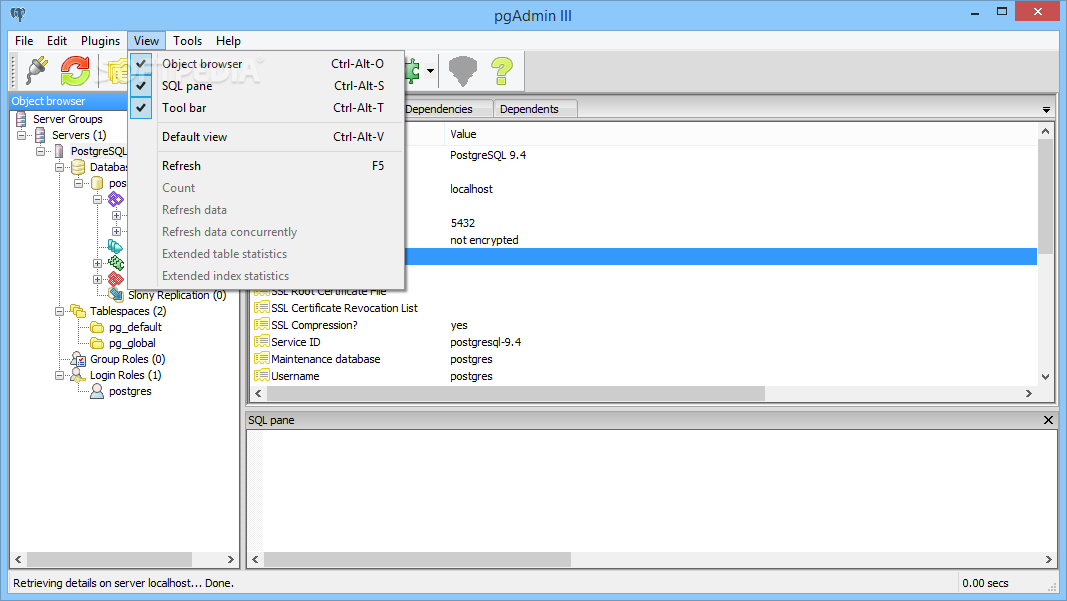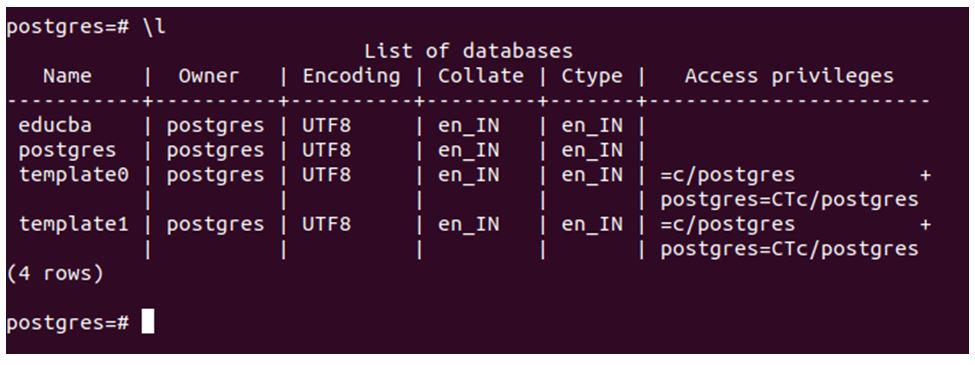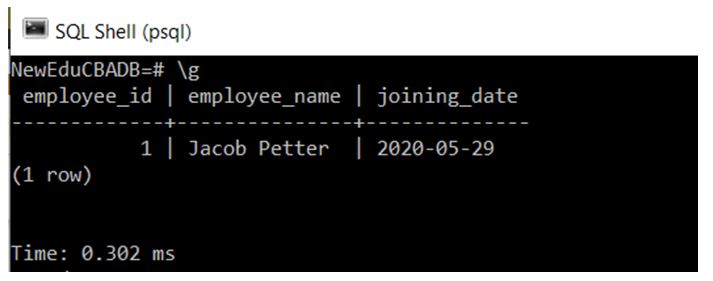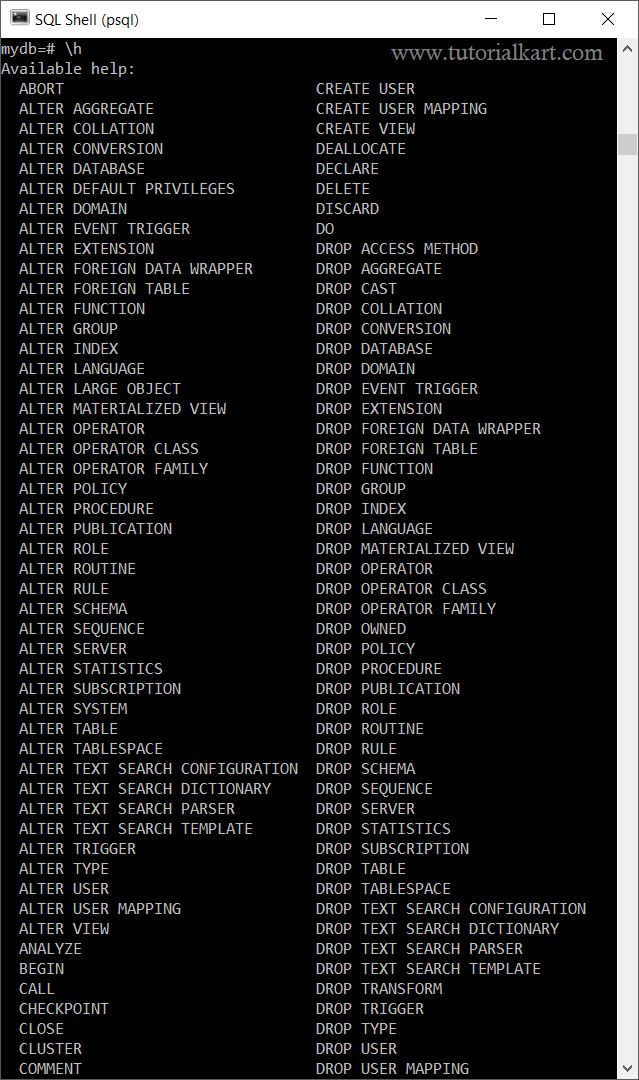

- Postgresql commands for mac os x#
- Postgresql commands mac os x#
- Postgresql commands install#
- Postgresql commands update#
- Postgresql commands full#
VACUUM FULL VERBOSE ANALYZE users fully vacuums users table and displays progress messages. VACUUM ANALYZE users vacuums and analyses users table. Other queries cannot access users table while vacuuming is running. VACUUM FULL users fully vacuums users table. VACUUM VERBOSE users vacuums users table and prints progress messages. This command doesn't allow any other read and write operations on the vacuumed table. The reclaimed storage space is returned to the operating system in this case. VACUUM FULL exclusively locks the table, creates a new table file, copies only live records to this file, then deletes the old table file. This command can be run in parallel with other read and write operations on the table. However, that storage space doesn't become available to the operating system. VACUUM reorganises live records in a table and makes the allocated storage space available for new records. VACUUM also has the ANALYZE option that tells it to analyze the table during vacuuming. The reason those records have to be removed is that they are only marked as unavailable but still occupy disk space, making table scans slower. VACUUM removes deleted records and previous versions of updated records. PostgreSQL VACUUM command reclaims storage occupied by dead records in database tables. That may help query planner to generate optimal query plans that will efficiently the new index. just before or after adding an index to a table. For example, when a few percents of records in a table have been added, updated or deleted. when the contents of a table has changed significantly. You may want to run ANALYZE in these situations: It also doesn't block the table - other queries may read from the table while ANALYZE is running. It deals only with table/column contents. Postgresql commands update#
Note that, in PostgreSQL, ANALYZE command doesn't read or update indexes.
ANALYZE collects statistics for all table in the current database.  ANALYZE users (id, display_name) collects statistics for id and display_name columns of users table. ANALYZE VERBOSE users does exactly the same plus prints progress messages. ANALYZE users collects statistics for users table. The PostgreSQL query planner then uses that data to generate efficient execution plans for queries. PostgreSQL ANALYZE command collects statistics about specific table columns, entire table, or entire database. Let's take a quick look at each of PostgreSQL database maintenance commands to understand what they do and when to use them. To help developers and database administrators deal with these issues, PostgreSQL has a few commands: ANALYZE, VACUUM, REINDEX. corrupted indexes, which means query planner can't generate efficient query execution plans for them and as a result DB performance degrades over time. table and index bloat, which means they occupy way more disk space and memory than actually required.
ANALYZE users (id, display_name) collects statistics for id and display_name columns of users table. ANALYZE VERBOSE users does exactly the same plus prints progress messages. ANALYZE users collects statistics for users table. The PostgreSQL query planner then uses that data to generate efficient execution plans for queries. PostgreSQL ANALYZE command collects statistics about specific table columns, entire table, or entire database. Let's take a quick look at each of PostgreSQL database maintenance commands to understand what they do and when to use them. To help developers and database administrators deal with these issues, PostgreSQL has a few commands: ANALYZE, VACUUM, REINDEX. corrupted indexes, which means query planner can't generate efficient query execution plans for them and as a result DB performance degrades over time. table and index bloat, which means they occupy way more disk space and memory than actually required. Postgresql commands install#
Brew Install Postgresql on OS X Lion - Resolving conflicts with the built-in PostgreSQL libraries shipping with OS X 10.Large and heavily updated database tables in PostgreSQL often suffer from two issues:. Postgresql commands mac os x#
Install PostgreSQL on Mac OS X via Brew.You can see which version the current latest is/will be by installing it and inferring it from the directory, running `brew info postgresql` or looking at the formula `brew edit postgresql` You can see what other versions are available for install by running $ brew services start postgresql # or "brew services run postgresql" to have it not restart at boot time When you do it will be "owned" by your username and create the `postgres` and `template1` databases. It will give you instructions on creating an initial database. If you want just the command line console (psql) to access remote databases, see here. This installs the command line console (psql) as well as a PostgreSQL server locally, so you can create your own databases locally if desired.


Typical installation of server looks like For installing elsewise in OS X see here. This type of installation might be preferred by people who are comfortable using the command line to install programs, such as software developers. It includes a version of PostgreSQL packaged by what it refers to as a formula.
Postgresql commands for mac os x#
Homebrew is a package manager for Mac OS X that builds software from its source code.








 0 kommentar(er)
0 kommentar(er)
